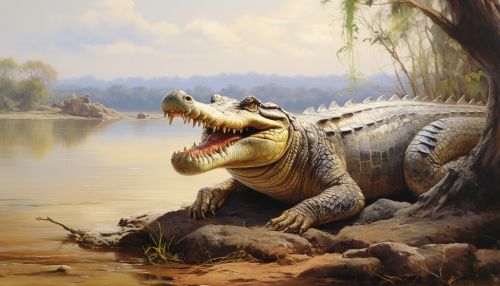Nile Crocodile
Taxonomy and Evolution
The Nile crocodile, scientifically known as Crocodylus niloticus, is a species of crocodile native to freshwater habitats in Africa. It is the second largest extant reptile in the world, after the Saltwater crocodile. The species belongs to the family Crocodylidae, which also includes other large predatory reptiles such as alligators and caimans.


The Nile crocodile is an ancient species, with fossil evidence suggesting that the species has been around for at least 6 million years. The species is believed to have evolved during the Miocene epoch, a period of time that saw the evolution of many modern mammal families.
Physical Characteristics
Nile crocodiles are large and powerful animals, with adult males typically reaching lengths of 3.5 to 5 meters, and females slightly smaller. The largest recorded individual measured 6.1 meters. They have a dark bronze colouration, with black spots on the back and a dirty purple on the belly. The flanks, which are yellowish green in colour, have dark patches arranged in oblique stripes.
Habitat and Distribution
Nile crocodiles are found throughout Sub-Saharan Africa, in regions south of the Sahara desert. They inhabit a variety of freshwater habitats, including rivers, lakes, marshes, and even man-made bodies of water such as reservoirs. They are known to be able to tolerate brackish water, but are rarely found in marine environments.
Diet and Hunting
Nile crocodiles are apex predators, meaning they are at the top of the food chain in their environment. They have a broad diet, feeding on a variety of animals such as fish, birds, and mammals. They are known for their ability to take down large ungulates, such as zebras and antelopes, which come to the water to drink.
Reproduction and Life Cycle
Nile crocodiles are sexually mature at around 12 to 16 years of age. They breed in the wet season, when females lay 25 to 80 eggs in a nest made of vegetation and soil. The eggs are incubated for approximately 90 days, with the temperature of the nest determining the sex of the hatchlings.
Conservation Status
The Nile crocodile is currently listed as Least Concern on the IUCN Red List. However, the species faces threats from habitat loss and hunting. They are hunted for their skin, which is used in the leather industry, and also for their meat.
Human Interaction
Nile crocodiles are known for their aggressive nature and are considered one of the most dangerous species of crocodile to humans. However, they also hold significant cultural and economic importance in many African societies, being featured in folklore and mythology, as well as being farmed for their skin.
